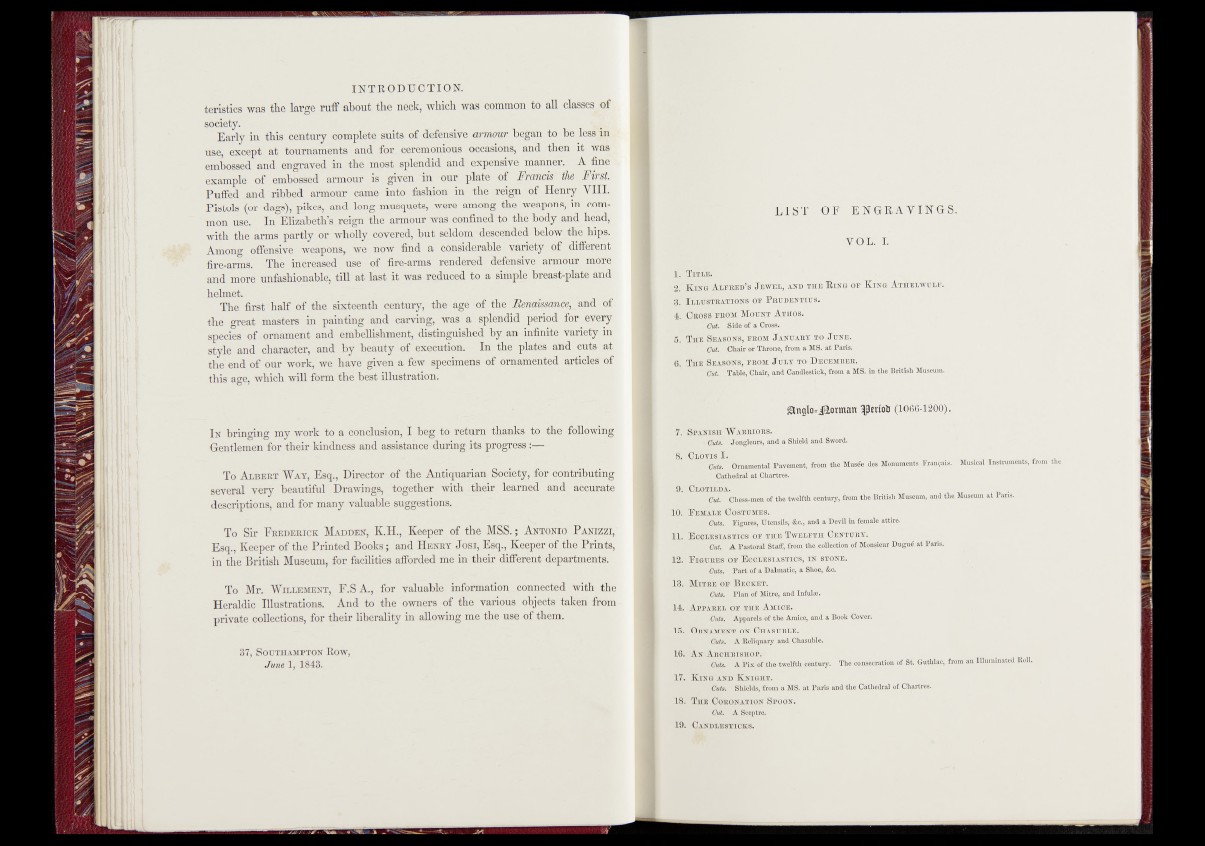
teristics was the large ruff about the neck, which was common to all classes^ of
society. . ’ , . " '
Early in this century complete suits of defensive armour began to be less in
use, except at tournaments and for ceremonious occasions, and then it was
embossed and engraved in the most, splendid and expensive manger. A fine
example of embossed armour is given in our plate of Francis the First.
Puffed and 'ribbed armour came into fashion in -the reign of Henry VIII.
Pistols“(or dags), pikes, and long musquets, were among the weapons, in common
use. In Elizabeth’s, reign the armour was confined the b d j|| andhgad,
with the' arms partly or-wholly covered, but seldom-descended below the hips.
Among offensive weapons, we now find a considerable variety of different
fire-arms. The increased. use of fire-arms rendered defensive armour more
and more unfashionable, till at last it was reduced to a simple breast-plate and
helmet; • . •. ■ - .... '
The first half of the sixteenth century, the-age of the Renaissance^ and of.
the great masters in painting mid carving, was-a splendid, period for' every
species of omament and embellishment, distinguished by an infinite variety in
style and character, and. by beauty of execution. In the plates and cuts at
the end of our work, we have given a few specimens of ornamented articles of
this age, which will form the best illustration.
I n bringing m y work to a conclusion, I beg to return thanks to the following
Gentlemen for their kindness and assistance during its progress':—
To A lbert W ay, Esq., Director of the Antiquarian,Sbcietyj for contribiiting
several very beautiful Drawings, together with-riieir learned and, accurate
descriptions, and for many valuable suggestions.
To Sir F r ed e r ick Madden, K.H., Keeper of the MSS. ; ibrroNio P a n izz i,
Esq., Keeper of the Printed Books ; and H en ey J osi, Esq., Keeper of the Prints,
in the British Museum, for facilities afforded me in their different departments.
To Mr. W ill em ent , F.S A., for valuable information connected with the
Heraldic Illustrations. And to the owners of the various objects taken from
private collections, for their liberality in allowing me the use of them.
37, S ou th ampto n R ow,
June 1, 1843-
tL T ST -O F EN G R A V IN G S .
VOL. I.
f; Title-
2. King Alfred' s J ewel, and the R ing o r K in s Atbilwitle.
3 ' TT.T.TfHT’R.A’PTONB OE P rHDENTIUS.
EBOMiMcraip Athqs.,
CutJ Side of a Cross.
5. The Seasons, ebom> J anuary to J une.
Out. Chair or Throne, from a MS. at Paris. -
6. 'Seasons, ebom J uly to December..
• Table, Chair, and Candlestick, from a MS. in the British. Museum.
gln0lo»i9,orman ÿetloïj ( * 6-1200).
0 | | S pantsh 'Warriors. ,
I, Cuts. 'Jongleurs, and a Shield and Sword.
^StiiiOvisT. ■ . ■ Outs. Ornamental. Pavement, from the Musde des Monuments Framjais. Musical Instruments, from
Cathedral at Chartres. ,
9.' Clotilda.
Cut. Chess-men of the twelfth century, from the British Museum, and the Museum-at Pans.
10. F emale Costumes.
Cuts. Figures, Utensils, &c., and a D.evil in female attire.
l | i i E cclesiastics oe the Twelfth Century.
.' - .Cut. A Pastoral Staff, from the collection of Monsieur Dugué at Paris.
1 2 .'F igures oe E cclesiastics, in stone.
Cuts. Part of a Dalmatic, a Shoe, Sso.
18. Mitbe oe B ecket.
Cuts. Plan of Mitre, and Infulse.
14. Apparel oe the Amice-
Outs. Apparels of the Amice, and’4 Book Cover.
15. Ornament on Chasuble.
Cuts. A Reliquary and Chasuble.
16. An Archbishop.
Cuts. APix of the twelfth century. The conseoratlon of S t Guthlac, from an Illuminated Boll.
.17. K ino and K night.
Cuts. Shields, from a MS. at Paris and the Cathedral of Chartres.
18. The Cobonation Spoon.
Out. A Sceptre.
19. Candlesticks.